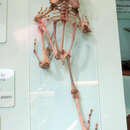pms
nòm ant ël fil


Discodeles guppyi és una espècie de granota que viu a Papua Nova Guinea i a Salomó.
Es troba amenaçada d'extinció per la pèrdua del seu hàbitat natural.
Discodeles guppyi és una espècie de granota que viu a Papua Nova Guinea i a Salomó.
Es troba amenaçada d'extinció per la pèrdua del seu hàbitat natural.
Cornufer guppyi (common name: Shortland Island webbed frog or giant webbed frog) is a species of frog in the family Ceratobatrachidae.[1][2] The species is named after British surgeon Henry B. Guppy who collected the holotype from the Shortland Islands.[3][4] It is found in New Britain Island (Papua New Guinea) and in the Solomon Islands archipelago, where it is widespread, though it is missing from Makira island (San Cristobal).[2]
C. guppyi is the type species and the sole representative of the subgenus Discodeles (formerly recognized as a genus).[5]
C. guppyi is a large species of frog, with females growing as large as 250 mm (9.8 in) in snout–vent length and a weight of 1 kg (2.2 lb).[5] The snout is rounded. The tympanum is round.[6] The fingers and toes have moderately expanded terminal discs. The toes are fully webbed.[5] The legs are long. Males have external vocal sacs.[7] Preserved specimens show variable colouration, from light tan/almost white to greyish to dark reddish brown, with various darker brown or blackish brown marbling or blotching. The venter is light tan or whitish, often with some brown blotches or speckles.[6]
Humans mostly use C. guppyi for food purposes, and it is tracked down by listening to its calls during rain, with March being said to be the best time to find it.[8] A whistle is sometimes used to find this frog because it will respond to the noise, and it is said that snapping a twig will fool the frog into thinking one of its legs has been broken. The frog C. guppyi is considered to be a sign of soil fertility if seen in a garden, and the tribes who hold this belief do not typically eat it. Its bones are also sometimes ground up and applied to skin to treat snake or centipede bites.
C. guppyi is a common species. It inhabits streams and small rivers in lowland rainforests up to elevations of 700 m (2,300 ft) above sea level. It also tolerates some habitat degradation and can be found in rural gardens and degraded forests. It is also known from caves. It can be locally impacted by habitat loss caused by logging, and by collection for human consumption and pet trade.[1] It is also eaten by domestic dogs and cats.[8]
{{cite book}}: CS1 maint: multiple names: authors list (link) {{cite journal}}: CS1 maint: multiple names: authors list (link) {{cite journal}}: CS1 maint: multiple names: authors list (link) Cornufer guppyi (common name: Shortland Island webbed frog or giant webbed frog) is a species of frog in the family Ceratobatrachidae. The species is named after British surgeon Henry B. Guppy who collected the holotype from the Shortland Islands. It is found in New Britain Island (Papua New Guinea) and in the Solomon Islands archipelago, where it is widespread, though it is missing from Makira island (San Cristobal).
Cornufer guppyi es una especie de anfibios de la familia Ceratobatrachidae.[1]
Es endémica del archipiélago de las islas Salomón.
Se encuentra amenazada por la pérdida de su hábitat natural.
Cornufer guppyi es una especie de anfibios de la familia Ceratobatrachidae.
Discodeles guppyi Discodeles generoko animalia da. Anfibioen barruko Ceratobatrachidae familian sailkatuta dago, Anura ordenan.
Discodeles guppyi Discodeles generoko animalia da. Anfibioen barruko Ceratobatrachidae familian sailkatuta dago, Anura ordenan.
Cornufer guppyi est une espèce d'amphibiens de la famille des Ceratobatrachidae[1].
Cette espèce se rencontre jusqu'à 700 m d'altitude :
Cette espèce est nommée en l'honneur d'Henry Brougham Guppy (1854-1926)[2].
Cornufer guppyi Boulenger, 1884 est un synonyme de Cornufer hedigeri Brown, Siler, Richards, Diesmos & Cannatella, 2015.
Cornufer guppyi est une espèce d'amphibiens de la famille des Ceratobatrachidae.
Discodeles guppyi é uma espécie de anfíbio da família Ranidae.
Pode ser encontrada nos seguintes países: Papua-Nova Guiné e Ilhas Salomão.[1]
Os seus habitats naturais são: florestas subtropicais ou tropicais húmidas de baixa altitude, rios, cavernas, jardins rurais e florestas secundárias altamente degradadas.[1]
Está ameaçada por perda de habitat.[1]
Discodeles guppyi é uma espécie de anfíbio da família Ranidae.
Pode ser encontrada nos seguintes países: Papua-Nova Guiné e Ilhas Salomão.
Os seus habitats naturais são: florestas subtropicais ou tropicais húmidas de baixa altitude, rios, cavernas, jardins rurais e florestas secundárias altamente degradadas.
Está ameaçada por perda de habitat.
Discodeles guppyi là một loài ếch trong họ Ranidae. Nó được tìm thấy ở Papua New Guinea và quần đảo Solomon. Các môi trường sống tự nhiên của chúng là các khu rừng ẩm ướt đất thấp nhiệt đới hoặc cận nhiệt đới, sông, hang, vườn nông thôn, và các khu rừng trước đây bị suy thoái nặng nề. Nó bị đe dọa do mất môi trường sống.
Phương tiện liên quan tới Discodeles guppyi tại Wikimedia Commons
Discodeles guppyi là một loài ếch trong họ Ranidae. Nó được tìm thấy ở Papua New Guinea và quần đảo Solomon. Các môi trường sống tự nhiên của chúng là các khu rừng ẩm ướt đất thấp nhiệt đới hoặc cận nhiệt đới, sông, hang, vườn nông thôn, và các khu rừng trước đây bị suy thoái nặng nề. Nó bị đe dọa do mất môi trường sống.